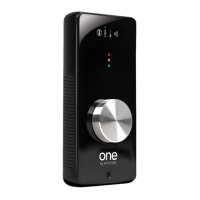16
ONE by APOGEE – User’s Guide
Maestro Mixer - Overview
Before describing the functions of Maestro’s Mixer window, a bit of
background information concerning latency and computer-based
digital recording setups will help to better understand these Mixer
functions.
When recording with most computer-based digital audio applications,
a delay between the input and output of the recording system
often disturbs the timing of the musicians who are performing. This
delay, known at latency, means that the musician hears the notes
he produces a few milliseconds after having produced them. As
anyone who has spoken on a phone call with echo knows, relatively
short delays can confuse the timing of any conversation, spoken or
musical.
Figure A
To illustrate the effect of latency, gure A depicts the typical signal
path of a vocal overdub session. A vocalist sings into a microphone,
which is routed through a hardware interface to the audio software
application for recording. In the software application, the vocalist’s
live signal is mixed with the playback of previously recorded tracks,
and routed back through the hardware interface to the vocalist’s
headphones. Because of the audio application’s latency, the vocalist
hears his performance delayed by several milliseconds in his
headphones.

